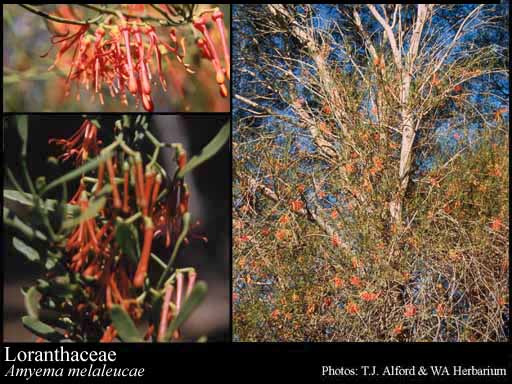- Reference
- Gen.Hist. 3:432 (1834)
- Name Status
- Current







Scientific Description
Common name. Mistletoe Family.
Habit and leaf form. Trees (Nuytsia), or lianas (a few), or shrubs (mostly ‘shrublets’); evergreen. ‘Normal’ plants, or switch-plants (occasionally); switch forms with the principal photosynthesizing function transferred to stems. Leaves well developed, or much reduced (rarely). Plants rootless (in the normal sense), or with roots (but with haustoria rather than root-hairs, e.g. Nuytsia?); more or less succulent (in Nuytsia), or non-succulent; partially parasitic (with haustoria which often induce gall-like growth of hosts). On aerial parts of the host (mostly), or on roots of the host (a few). Stem growth conspicuously sympodial. Mesophytic, or xerophytic. Leaves usually opposite; leathery (usually), or fleshy, or membranous (rarely); edgewise to the stem, or with ‘normal’ orientation; simple. Leaf blades entire; one-veined, or pinnately veined, or parallel-veined. Leaves without stipules. Leaf blade margins entire. Leaves without a persistent basal meristem. Stem anatomy. Nodes unilacunar. Secondary thickening developing from a conventional cambial ring, or anomalous; when anomalous, via concentric cambia (Nuytsia).
Reproductive type, pollination. Fertile flowers hermaphrodite (usually), or functionally male and functionally female. Unisexual flowers present, or absent. Plants hermaphrodite (nearly always), or monoecious (Nuytsia). Entomophilous, or ornithophilous.
Inflorescence and flower features. Flowers aggregated in ‘inflorescences’; in cymes, in racemes, in spikes, in fascicles, and in umbels. The terminal inflorescence unit cymose (the flowers often in threes). Inflorescences dichasial, the dichasia sometimes resembling racemes, spikes, umbels etc. Flowers bracteolate (the two bracteoles adnate to form a ‘calyculus’ external to the calyx); regular to somewhat irregular. The floral asymmetry involving the perianth. Flowers cyclic; tetracyclic. Floral receptacle markedly hollowed. Free hypanthium absent. Perianth with distinct calyx and corolla, or petaline (the calyx much reduced, often to a mere rim), or absent (sometimes, in Amyema?); 3–9; 2 -whorled, or 1 -whorled (with the calyx obsolete). Calyx 1 -whorled; gamosepalous (reduced to a lobed or toothed cup or rim); entire (often), or lobed; when not entire, lobulate, or blunt-lobed, or toothed; open in bud; regular; persistent. Corolla (3–)5–6(–9); 1 -whorled; polypetalous, or gamopetalous; valvate; often tubular (the tube often bent and split down one side); unequal but not bilabiate, or bilabiate, or regular; often yellow, or orange, or red. Androecium (3–)5–6(–9) (as many as C). Androecial members adnate (to the corolla); free of one another; 1 -whorled. Androecium exclusively of fertile stamens. Stamens (3–)5–6(–9); isomerous with the perianth; alternisepalous (opposite the petals). Anthers dehiscing via longitudinal slits; introrse; bisporangiate, or tetrasporangiate. Gynoecium 3 carpelled, or 4 carpelled. The pistil 1 celled. Gynoecium syncarpous; synstylovarious, or eu-syncarpous; inferior. Ovary unilocular; 1 locular. Ovules not differentiated; in the single cavity 4–12; sessile; ascending; non-arillate; not clearly differentiated from the placenta.
Fruit and seed features. Fruit fleshy (usually), or non-fleshy (rarely, e.g. sometimes in Nuytsia); indehiscent; usually a berry, or a drupe (the fleshy part being receptacular), or a nut (sometimes, when not fleshy). Seeds copiously endospermic. Endosperm oily. Seeds covered with viscous material; without a testa. Embryo well differentiated. Cotyledons 2, or 1 (often becoming fused). Embryo chlorophyllous (2/2). Seedling. Germination phanerocotylar, or cryptocotylar.
Physiology, biochemistry. Aluminium accumulation not found.
Geography, cytology, number of species. World distribution: pantropical and warm (especially South) temperate. X = 8–12. 940 species.
Keys
Western Australian Genera and Families of Flowering Plants — an interactive key
T.D. Macfarlane, L. Watson, N.G. Marchant